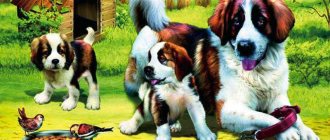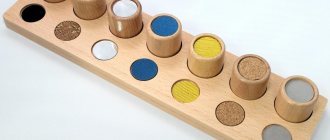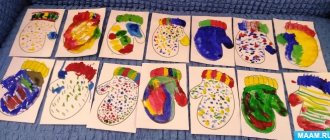Lesson summary: “Telling a story based on a set of toys”
Lesson summary: “Making a story based on a set of toys”
Developed by: Andrianova S.G.
Target:
teach children to compose a story to compose a plot story, choosing appropriate characters (toys) for it.
Tasks:
Educational:
develop the ability to compose a story using a set of toys, give descriptions and characteristics of characters, introduce dialogue into the story, learn to select definitions for given words, practice composing sentences from a set of words, independently come up with sentences of two or three words.
Educational:
continue to develop vocabulary, develop attention, memory, imagination, initiative.
Educational:
continue to cultivate a caring attitude towards the environment.
Material:
Toys: doll, bunny, kitten, puppy, bear, Christmas tree; pictures: owl, piglet, baby elephant, puppy, goldfinch, brush.
Progress of the lesson:
The teacher draws the children's attention to the toys on his table. He asks questions about each toy (What kind of doll (girl)? – description of appearance. What is her character like? – listing of character traits. What is the girl’s name?)
- Now write a story about a girl. The girl went into the forest. Who did she meet? (Bunny, bear cub.) What happened next, you will tell yourself.
- And if the girl didn’t go into the forest, who could she?! meet? (Kitten, puppy.)
– When you tell the story, take these toys and show what you came up with about them. Think about what the girl was talking about with the animals. What day was it?
The teacher suggests that several children unite in a group for storytelling. He asks: “What do you need to agree on?” (Who will talk about what, who will start the story, etc.)
Each child takes a toy, the children agree on what they will talk about. The rest listen to the story, come up with a title for it and give a rating.
Physical education minute
The teacher addresses the group:
- Let six children come to me now. They will be different words.
The teacher tells each child what word he is! After that, he checks how everyone remembers the words. A set of words: kitten, girl, fun, fast, runs, jumps.
The teacher explains the task:
– From these words you can make various sentences, about a girl or about a kitten. The sentence should consist of two or three words. Whoever comes up with a proposal will raise their hand. You shouldn’t say in advance what the sentence is - you need to arrange the words in order, and then “read”.
The child comes to the table and, without saying words, makes a sentence.
“Now tell me what sentence you came up with,” the teacher suggests. (The child names the sentence.) Let's check if you put the words correctly. Words, name yourself in order (this way, the correspondence of the sentence named by the child with the one he made from “living words” is checked).
Lesson summary “Writing a descriptive story about a toy - a fox”
Irina Mishutkina
Lesson notes “Composing a descriptive story about a toy - a fox”
Goal: to create conditions for children to develop the ability to write a descriptive story based on a toy .
To develop in children the ability to answer questions in complete sentences and to compose a descriptive story based on the teacher’s questions.
Develop attention, memory, auditory and visual perception.
Cultivate perseverance and the ability to listen to each other.
Vocabulary: fox, fox, fox, cheat
Equipment and materials for classes in kindergarten :
multimedia projector, laptop, toy fox , magic bag.
teacher Melikova F.M.
DIRECT EDUCATIONAL ACTIVITY educational area “Speech development”
Program content : Check how well children have developed the ability to compose a consistent story about a toy. Exercise children in the ability to form words by analogy.
Tasks:
Educational objectives: To strengthen children’s ability to describe a toy, naming the most characteristic features and various actions with them. Continue to teach how to connect sentences with each other, leading to writing a short story about toys. Practice choosing synonyms and antonyms.
Educational tasks: To cultivate a friendly attitude towards friends, animals, toys. Teach children to put their toys back in their place.
Developmental tasks: Enrich children's vocabulary with the names of surrounding objects (toys, their properties and actions).
Equipment: Toys (pyramid, soft toy hare, doll, car, ball, magic bag)
Progress of the lesson.
| parts | content | methods and techniques |
| Introductory part | Educator: All the children gathered in a circle. I am your friend and you are my friend! Let's hold hands together and smile at each other. (Children sit down, knock on the door) | greetings |
| Main part. | Educator: Oh, guys, do you hear someone knocking on the door. Let's see who's there? (The teacher opens the door, and behind the door is a bag with a letter.) Educator: Guys, here is a letter with riddles that need to be solved. Listen carefully to the riddles and before answering, think. The teacher asks riddles: Teacher: A ball of fluff, a long ear, jumps deftly, loves carrots (hare) He is small in stature, but he is daring, he galloped away from me. Even though it’s always inflated, it’s never boring with it (the ball) Doesn’t fly, doesn’t buzz, the beetle runs down the street, and two brilliant lights are burning in the beetle’s eyes. (car) Blue eyes, golden curls, pink lips. (doll) There are different rings on sticks, they look like a Christmas tree, they amuse the children. (pyramid) Educator: Guys, what is this, how can all this be called in one word. (toys) Educator : Guys, let's play a finger game. A small hare with big ears, a pink nose, and a funny mustache. He digs a deep hole for himself. With strong paws in soft ground. He cleans his fur or sleeps. The bunny always moves his ears. Educator: Let's write a story about toys together. (The teacher takes one of the toys and begins to describe it with the children) Educator : By color, what kind of toys there are, by shape, by size, from what materials (children's answers). Well done boys. Educator: Guys, let's talk about the doll together. (Children's answers) Educator: What is she like, what is she wearing. (Children's answers). Educator: I invite anyone who wants to come up and take any toy (doll, car, pyramid, ball, hare), and the rest help. Educator : And now everyone stood in a circle to play, it’s time. Our game is called “What is What?” The teacher gathers children in a circle. Educator: I will tell you the juice, and you must guess what fruit it is made from. (Orange juice, from orange; apple juice, from apples.) | Surprise moment Guessing riddles Finger game Making up a story game “What from what” |
| Final part | Educator: Guys, you liked our game. What we talked about today. Guys, did you like our new toys? Now you can take the toys and play with them. | Summary of the lesson. |
Lesson duration : 20 minutes.
Node progress
I organize the children for the lesson, seat them at tables. I say: Children, on the street and at home you see different kittens. Tell me, what kinds of kittens are there? (small, fluffy)
.
And when they are played with, what are they like? (playful, mischievous, cheerful)
.
Let's talk about one kitten. What is he like? (affectionate, small, what can a kitten do? (jump, lap milk, play)
.
Now I will tell you a story about Masha and the kitten ( the story is accompanied by a show)
.
This is Masha, she comes home from a walk and sees a little kitten lying and meowing pitifully, like this: meow-meow (plaintive intonation)
.
How does a kitten meow? (children repeat intonation)
.
Masha took the kitten in her arms and carried it home. At home I poured milk into a saucer. The kitten was happy about the milk and meowed joyfully, like this: meow-meow (pronounced joyfully, cheerfully)
.
How did he meow? (children repeat intonation)
.
The kitten drank milk and fell fast asleep. Then the dog Bug came running and began barking loudly at the kitten: Af-Af! How did she bark? The kitten got angry and meowed . How did the kitten meow? The Bug got scared and fell silent. And Masha said: “Let’s play together, we must live together
. And the kitten meowed joyfully again. How? And the dog barked cheerfully. How? And no one was afraid of anyone.
Which of you wants to tell about Masha , the kitten and the dog Zhuchka with me? I call three children. I begin to tell the story together with the first child: “This is Masha. She is walking home from a walk. Suddenly she saw a kitten. He meowed pitifully: meow-meow. Masha took the kitten in her arms and carried it home.” Then, with my help, another child says : “Masha poured milk into a saucer, and he began to lap it up. When he got drunk, he meowed joyfully (meow-meow)
and went to bed."
Then the dog Bug came running and barked loudly (af-af)
.
The kitten got angry and meowed angrily (meow-meow)
.
The story continues with the third child. “The Bug got scared and fell silent. And Masha said: “Let’s play together, we must live together.”
.
The kitten meowed joyfully, the dog barked happily. The story is repeated twice , with a new group of children . Children talk on their own , and I provide help if necessary. Then one of the children tells the story in full .
I invite the children to imagine that they are kittens and run out for a walk. Kittens wash themselves with it happily, they meow joyfully. Children perform actions, repeat onomatopoeias with appropriate intonation.
The lesson continues. The children take their seats.
Guess how the kitten meows? (complaining)
.
And now? (angrily)
.
And now? (complainingly)
.
How does a kitten purr? (purr purr)
.
What does a mosquito call? (z-z-z)
.
Well done. Pronounce the sound “z”
loudly and protractedly with one exhalation.
Then I name the words, and the children clap their hands when they hear the sound “z” (bunny, bear, goat, mushroom, umbrella, etc.)
.
I praise the children, well done guys. I draw a conclusion from the lesson about what we did during the lesson. Today we had a good time with you, we talked about the kitten , the dog Zhuchka and the girl Masha. You told and listened attentively. This concludes our lesson, you can get up quietly and go play with toys .
Synopsis of a frontal lesson on the development of coherent speech “Composing a story based on a series of plot paintings “Tangle” Correctional and educational goals. Activation and updating of the dictionary on the topic “Pets”. Formation of a holistic impression about.
Notes on the development of coherent speech in the senior group “Composing descriptive stories based on a set of toys” Compiling descriptive stories about insects (based on a set of toys) Tasks. Coherent speech: teach children to write descriptive stories.
Summary of the educational situation in the Senior group Topic: “Composing a story based on a set of toys” EXPLANATORY NOTE. 1. NGO "SPEECH DEVELOPMENT". 2. OS topic “Making a story based on a set of toys.” (method. lit. - ra O. S. Ushakova). Lesson notes for a senior speech therapy group. Topic: “Migratory birds. Compiling the story “Birdhouse” Lesson notes for a senior speech therapy group. Topic: “Migratory birds. Compiling the story “Birdhouse” based on a series of plot pictures.
Lesson notes for older children. Topic: “Drafting a descriptive story based on mnemonic tables” Program content: Educational objectives: 1. Teach children to establish logical connections in the development of the storyline 2. Summarize the accumulated ones.
Lesson summary using TRIZ “Composing a story based on the painting “Village Yard” MUNICIPAL AUTONOMOUS PRESCHOOL EDUCATIONAL INSTITUTION COMPENSATING KINDERGARTEN No. 3 “RAINBOW” Master class with elements.
Outline of an integrated lesson on speech development “Composing a story on choosing military-themed toys” Topic: Composing a story on choosing military-themed toys. Goal: mastery of speech as a means of culture and communication, enrichment of active.
Outline plan for speech development in the middle group “In a toy store” (drawing up a descriptive story about a toy) Department of Education of the Administration of the Municipal District of the Tuymazinsky District of the Republic of Bashkortostan Municipal budgetary preschool.
Compiling a descriptive story with children of senior preschool age with special needs development. Topic “Vegetables” Topic “Vegetables” Goal: Formation of skills to write a descriptive story on the topic “Vegetables” Educational Objectives: • Consolidation of ideas.
Source




